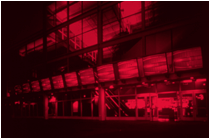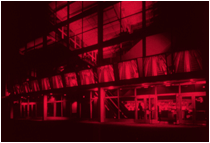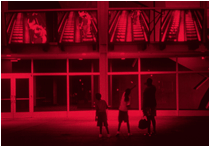
Bragança
de Miranda
Machine: The Funcional Impossibility
Carrilho da Graça
Performance (Interview)
Diller + Scofidio
Jump Cuts
Hani Rashid
The Diference-scape: The Digital Machine
Neil Denari
Interruped Projections
Rui Tavares
Seapking of Miguel Palma
Santa-Rita
The Mechanical Flirt
Machine: The Funcional Impossibility
Carrilho da Graça
Performance (Interview)
Diller + Scofidio
Jump Cuts
Hani Rashid
The Diference-scape: The Digital Machine
Neil Denari
Interruped Projections
Rui Tavares
Seapking of Miguel Palma
Santa-Rita
The Mechanical Flirt





"Jump Cuts"
New York 1998
Visual culture suffers from two parallel pathologies: technophilia and technophobia. The technophylic embrace of the electronic age, not unlike the early zealotry of the machine age, stems from a conviction in a radical discontinuity with existing social, political and cultural structures. And like the early years of modernism, the air is thick with the rhetoric of the "new" and the newly obsolete. The technophobic rhetoric of "loss", which blames the steady incursion of media technologies for the dismantling of cultural values, poses technology in moral opposition to family, community, and authentic-qualitative experience.
While the technophilic narratives of progress and the technophobic narratives of decline are at ideological odds with one another, their oppositional framework at times and unexpectedly reveals flip sides of the same desires. One of the biases shared by the techno-extremes is the attraction to "livenes". "Live" is a broadcast term which means simply, now, at this very moment. Live cannot be thought if not in relation to the not-live: there was no such thing as live prior to the advent of recording media. Liveness holds with it the titillation of the unmediated, the uncut, the uncensored, and the not fully controlled. Liveness turns the passive viewer receiving messages into an eyewitness.
For technophobes who believe that media mediates reality, "liveness" in broadcast may be the last stronghold of authentic experience-seeing and/or hearing the event at the precise moment of its occurrence. So long as time is undistorted, immediacy is not entirely surrendered to distance. The Gulf War, the Academy Awards, the World Cup are global events in which distant spectators are fused by an electronic weld.
For technophiles, liveness is the index of technology´s ability to simulate the real... in real-time. Lag time, delay, search time, download time, response time, feedback time are unwelcome detractions from liveness. Real-time is the speed of computational performance, the ability of the computer to respond to the immediacy of an interaction without any temporal mediation. Un-mediated means im-mediate. But, whether motivated by the desire to preserve the real or to fabricate it, liveness is synonymous with the real, and the real is an object of uncritical desire for both techno-extremes.
New technologies are blamed for the death of the public realm and for the privatization of space. New-media hype boasts about its role in supplanting conventional notions of public space with electronic surrogates. But can the public realm, apparently lost to media, be defined outside of the media? Have not the terms "the public" and "media" been indistinguishable since the invention of the printing press? What is this public, in whose name this binary war is being waged?
Jump Cuts is a permanent public art installation at the United Artists Cineplex theater in San Jose, California in which public space and live, mediatized images are in a perpetual interchange with the so-called "unmediated". The piece straddles the curtain wall of the newly built movie theater designed by local architects. Following the resurgence of extravagant lobbies in theaters, it is a huge exhibitionistic circulation space speared by free-standing escalators and flying pedestrian bridges. The work tries to undermine the hierarchy that defines live and mediated experiences and exploit new exchanges between them.
The difference between liveness in broadcast and liveness in surveillance is the diferrence between the act of witnessing and the act of monitoring. Whether an illicit or officiall gaze, the ubiquity of surveillance cameras has left few shadow zones of privacy.But where surveillance was once considered invasive, it is now the accepted social contract in public space, even a welcome assurance of security. Surveillance technology has produced a transparent world in which its own presence has become transparent. The glass curtain wall has gone through a similar cycle of public response. Glass was once considered a material of disclosure for the new, democratized vision of early modernism. It soon became evident that glass was, unexpectedly, a two-way system (if one could see the outside, one could also be seen from that very same outside). Glass had become a medium of optical transgression, an anxious material. However, as glass architecture became the dominant building technology of the 20th century, it produced an overexposure, which led to a blindness. Glass became, as it always wanted to be: invisible. The surveillance camera and the curtain wall are interwoven in this re-considered "marquee".
Adding to the atmosphere of spectacle already at play in the theater, the installation teases visual accessibility into the glazed lobby by flipping the building inside-out and back, electronically. An armature appended to the theater's north facade supports twelve liquid crystal panels which phase between transparent surfaces and translucent projection screens. Twelve video projectors, cantilevered into the interior, sequence direct feed from a series of live cameras positioned over the escalators which scan bodies in plan and elevation, movie trailers advertising present films, and direct views through the glass wall.
The traditional theater marquee once encroached into the civic space of the sidewalk to announce an event in a mute space beyond: the marquee is a form of urban seduction. This piece seduces by toggling between visual access and denial, by equating the spectacle of movies with the spectacle of moving bodies on parade; and by exchanging live bodies in deep space seen through the curtain wall with the their live video counterparts... flattened, reconfigured and broadcast to the street.
Glass architecture in combination with surveillance technologies allegedly have produced a transparent world. But, did this transparency lead to new tactics of secrecy? Or, more interestingly, did visual availability lead to new tactics of display? Perhaps, the paranoia has shifted in the last decades: the fear that someone is watching has shifted to the fear that no one may be watching. Postmodern narcissism may have turned yesterday´s pathologies into today´s signs of good health. Glass and surveillance screens have perhaps become calculated surfaces on to which performance is projected and from which it is read |